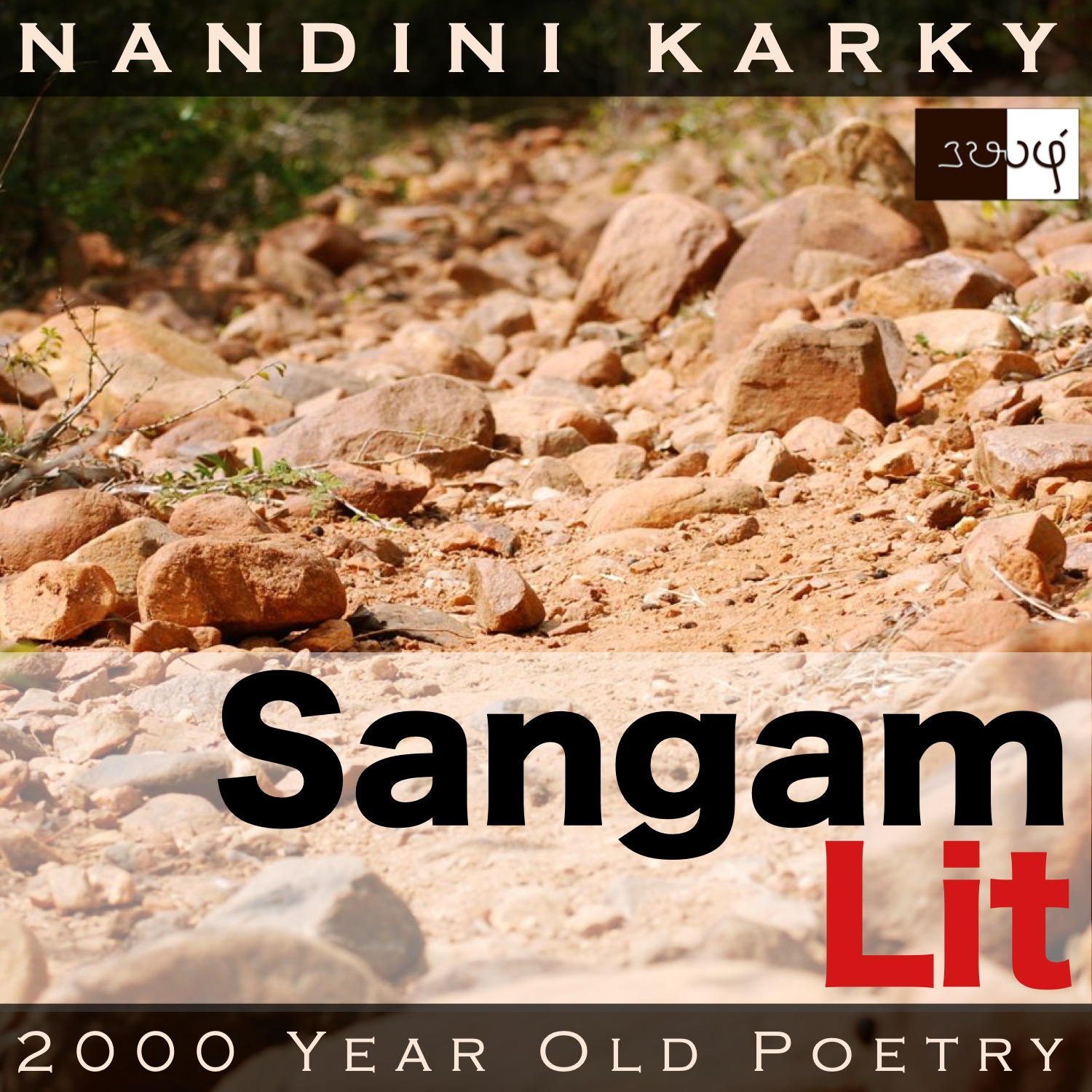Podcast: Play in new window | Download
Subscribe: Apple Podcasts | Spotify | Amazon Music | Android | iHeartRadio | TuneIn | RSS | More

In this episode, we take a walk through the inner and outer world laid out in Sangam Literary work, Natrinai 79, written by Kannakanaar. The poem is set in the ‘Paalai’ landscape or the drylands and revolves around the theme of separation. Speaking in the voice of the lady to her confidante, the poem expresses the anxiety in the lady’s heart on perceiving the man’s intention to part away on a journey.
‘சிறை நாள் ஈங்கை உறை நனி திரள்வீ,
கூரை நல் மனைக் குறுந் தொடி மகளிர்
மணல் ஆடு கழங்கின், அறை மிசைத் தாஅம்
ஏர் தரலுற்ற இயக்கு அருங் கவலைப்
பிரிந்தோர் வந்து, நப்புணரப் புணர்ந்தோர்
பிரிதல் சூழ்தலின், அரியதும் உண்டோ?’
என்று நாம் கூறிக் காமம் செப்புதும்;
செப்பாது விடினே, உயிரொடும் வந்தன்று-
அம்ம! வாழி, தோழி!-
யாதனின் தவிர்க்குவம், காதலர் செலவே?
Opening with the word ‘சிறை’ meaning in current day as ‘prison’ and in this ancient reference as a ‘hedge’ or ‘fence’, the poem captures our hearts right away. We meet and greet ‘ஈங்கை’, or the ‘twisted acacia’ tree, which we will get to know better shortly. The word ‘உறை’ appears in the meaning of ‘drops’ and ‘honey drops’ to be specific, as we say hello to the accompanying word, the familiar ‘வீ’, which is the short and sweet word for a ‘flower’. The past meaning of the word ‘கவலை’, currently used to mean ‘worry’ simply amazed me. This is because here it means a ‘diverging path’ or ‘a fork in the road’. Perhaps, the worry of many a Sangam maiden at the thought of her man leaving her and taking that diverging path away from her, has endowed the ancient word for path, ‘கவலை’ with the later meaning of ‘worry’. Indeed a testimony to the unlikely roads that words seem to take!
The man intends to leave on a task, parting away from his lady. Getting to know this, the lady turns to her confidante and says, “The nectar-filled, bushy flowers of the fence-like ‘eengai’ tree, fall on the rocks of the dryland path. These fallen flowers appear like the ‘kazhangu’ seeds, used as a play thing on the sand by bangle-wearing maidens, who live in well-roofed, fine houses. To walk through such a rocky, desert path, which is hard to traverse because of its rising slope, my man left me once before. He returned and my beauty that had left me, returned and united with me too. In such a situation, if he’s thinking of parting again, could there be anything more difficult to handle? I need to tell this to him and express my desire that he should stay. If I don’t, his separation is bound to cause irreparable damage to my very life. So listen, my friend, may you live long! I don’t think there’s any other way to avoid my love’s parting away!” With these words, the lady expresses her intention to speak of her anxiety to the man and request him to avoid that distressing journey.
Walking further down this rocky path, before our eyes rises the ‘eengai’ or the ‘twisted acacia’ tree. Searching for details about this tree, I was struck by the description of this tree in a scientific paper published for a project by the CSIR, India. The paper, right after the opening line describes the tree as a ‘a good, defensive hedge plant’. Turning back to our poem, isn’t it stunning that it too opens with ‘சிறை நாள் ஈங்கை’, talking about its quality of being a hedge or a fence. A scintillating feeling to glimpse this tree shining the same way in the eyes of an ancient poet and a modern scientist! We turn our attention to the flowers of this tree. These creamy-white, rounded flowers are said to be falling on the rocks of the drylands path and seem to resemble the ‘Kazhangu’ seeds or the seeds of the clearing-nut tree, which has been used by girls and women in ancient times as a play thing. Maybe because habitats were destroyed, such games later turned out to be played with stones and pebbles. Back to our poem, there is an important clue hidden by mentioning these flowers. Turns out the flowering season of this tree is from July to September, which happens to coincide with the ‘கார்காலம்’ or the ‘rainy season’, a time when Sangam couples couldn’t bear to be apart. So, the lady, by mentioning the flowers lets us know that it’s the wrong season for the man to be thinking of parting away from her. Thus, the poem subtly stitches the season as a reason for the lady’s pain.
Trying to understand the lady’s mind further, we see that she’s caught between the right thing of not stopping the man in his duty and the danger that seems to loom ahead to her very life because the man is to part away from her. While circumstances and relationships have changed over the years to be able to handle such separation more effectively, the takeaway from this poem is the importance of good communication. Like the lady, expressing how the other’s decision affects one internally, would go a long way in smoothening the rocky path of relationships!




அருமை….கேட்ககேட்க ஆனந்தம்…..